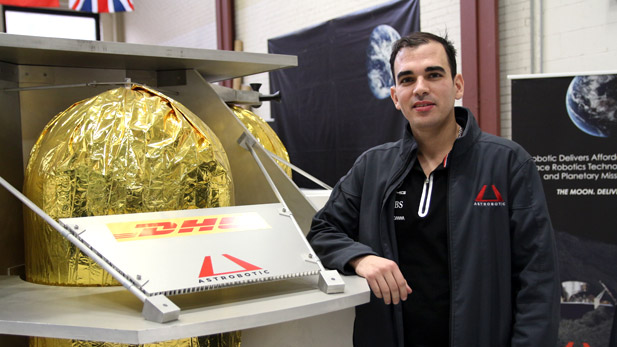Opening the Door to Return to the Moon

Ander Solorzano, a 2013 electrical engineering alumnus, has assisted in the development of Astrobotic Technology’s Peregrine lander, scheduled for a mission to the moon early in 2021.
A 2013 Rose-Hulman electrical engineering alumnus, Ander Solorzano, is a lead systems engineer for one of three companies selected to haul scientific equipment to the moon in preparation for humankind's return to the lunar surface by 2024.
NASA awarded Astrobotic of Pittsburgh a $79.5 million contract to fly as many as 14 payloads of equipment to the moon by July 2021, according to a space agency news release. Two other U.S.-based companies were also awarded multi-million-dollar contracts to send payloads to the moon's surface in the next couple of years.
NASA announced all three contracts on May 31 after a nine-company competition to win the space agency's business.
"The companies we have selected represent a diverse community of exciting small American companies, each with their own unique, innovative approach to getting to the moon," said Chris Culbert, Commercial Lunar Payload Services program manager at NASA's Johnson Space Center in Houston. "We look forward to working with them to have our payloads delivered and opening the door for returning humans to the Moon."
Last fall, NASA awarded Astrobotic a $10-million contract to create a vision-based precision landing system for their lunar lander, Peregrine. The lander is being designed to deliver cargo shipments for companies, governments, universities, non-profits, and individuals — showcasing that such transport could become a profitable venture.
Solorzano joined Astrobotic after spending nearly three years working with NASA’s Marshall Space Flight Center (Maryland) and John Glenn Research Center (Cleveland), through the Lunar CATALYST program, to develop the Peregrine lander. He has supervised the implementation of the vehicle’s electrical power storage, power generation, power management, guidance navigation systems, and avionics control systems.
Peregrine provides a delivery service to the moon, carrying nearly 200 pounds with rovers, science experiment modules and a variety of commercial technology demonstration payloads bolted to the top and undersides of one of its four payload decks. Once on the surface, Peregrine functions as a local utility station providing power and communication to deploy, support, and facilitate the operation of its payloads on the surface of the moon.
“We have a core lander with adaptable payload decks, depending on the customer’s needs,” Solorzano says. “We started simple, with several design constraints about keeping things small and agile. There have been challenges around every corner. We learned early on to appreciate what NASA and others accomplished (50 years ago) by putting a lander on the moon. It wasn’t easy then and it’s not easy today, but we’re getting close. I can’t wait until we get back to the moon and beyond.”
Peregrine will land in a flat plateau site located in the Lacus Mortis (Latin for “Lake of Death”) on the near facing side of the moon, at 45 degrees latitude. The site is close to an underground volcanic lunar tube which could provide breathtaking discoveries necessary for supporting long-term missions in space.
Peregrine’s maiden voyage is planned for early 2021 and Astrobotic already has 12 signed commercial deals for that first mission from companies in the United States, Japan, Mexico, Germany, Hungary and Chile.